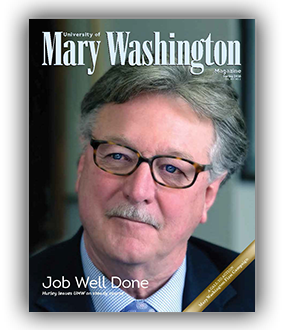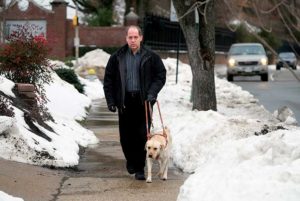By Edie Gross
Winter is off duty, so he greets a visitor to his Fredericksburg home with all the tongue-lolling, tail-wagging enthusiasm a Labrador pup can muster – which is a lot. Then he settles with a contented sigh at the feet of Brian Parsons ’85.
But when Winter steps outside each morning for the duo’s two-hour commute to Washington, D.C., the Seeing Eye dog is all business. He guides Parsons to a nearby bus stop, onto a train, onto Metro, and finally to an office at the Department of Homeland Security, where Parsons has worked since 2006.
“When you put the harness on, he becomes completely locked in,” Parsons says of the dog he partnered with in September 2015. “It’s like a knife through butter going through Union Station now. It’s like a Swedish slalom – he’s weaving me in and out of people, and I’m along for the ride. He’s amazing.”
Parsons, who has been legally blind since birth, had used a white cane since middle school to detect obstacles in his path. But in recent years, even with some limited peripheral vision, Parsons noticed that navigating through hordes of commuters in Union Station and finding the right Metro and train platforms had grown more challenging. After careful thought and consultation with friends and family – including wife Carolyn Sydnor Parsons ’83 – Parsons applied to The Seeing Eye, a nonprofit that has matched blind people with meticulously trained guide dogs for nearly 90 years.
The organization took note of Parsons’ lifestyle, his long commute, even his gait and where his hand fell relative to a dog’s harness, before matching him with Winter for a monthlong training class at its Morristown, New Jersey, headquarters.
For decades, Parsons used his white cane to note familiar landmarks. But Winter steers his partner around walls, buildings, and other impediments, meaning Parsons had to retrain the way his brain envisions his environment. He had to learn to trust the dog’s skills, while also correcting Winter if he sensed the 2-year-old had lost focus.
“By the second week, I started to realize, ‘I think this is going to work. I think this is right for me,’ ” Parsons said.
It’s hard to resist Winter’s charms, but Parsons said his colleagues at Homeland Security do a great job of treating the 60-pound Lab like a co-worker rather than the office mascot. Parsons has been a senior policy adviser at the federal agency’s Office for Civil Rights and Civil Liberties for nearly a decade, making sure that disaster preparedness plans take into account individuals with disabilities as well as those with limited English skills, transportation hardships, and other needs.
Parsons said his environmental science degree from Mary Washington has come in handy; he had no trouble understanding the physics behind a tidal surge – and the resulting damage – when he deployed with FEMA after Hurricane Ike in 2008 and Hurricane Sandy in 2012. He also does a fair amount of technical writing on the job, another skill he said he picked up at Mary Washington.
But every few hours, he said, he gets up from his keyboard and takes his partner for a well-deserved walk.
“He brings so much enthusiasm and energy into my daily life,” Parsons said of Winter. “I’ve lost weight – he’s my personal fitness trainer.”

